
National Hispanic Heritage Month, which begins each year on Sept. 15, celebrates U.S. Latinos, their culture and their history. Started in 1968 by Congress as Hispanic Heritage Week, it was expanded to a month in 1988. The celebration begins in the middle rather than the start of September because it coincides with national independence days in several Latin American countries: Guatemala, Honduras, El Salvador, Nicaragua and Costa Rica celebrate theirs on Sept. 15, followed by Mexico on Sept. 16, Chile on Sept. 18 and Belize on Sept. 21.
Here are some key facts about the nation’s Latino population by geography and characteristics like language use and origin groups. How we did this
The U.S. Hispanic population reached 62.1 million in 2020, up from 50.5 million in 2010. The 23% increase in the Hispanic population was faster than the nation’s growth rate (+7%), but a slower increase than in the Asian population (+36%). In 2020, Hispanics made up nearly one-in-five people in the U.S. (19%), up from 16% in 2010 and just 5% in 1970.
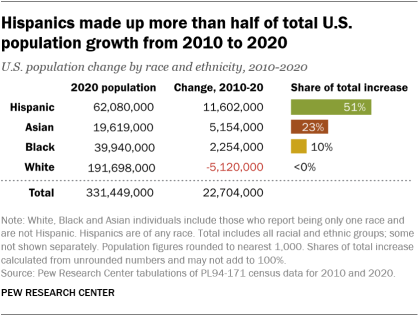
Hispanics have played a major role in driving U.S. population growth over the past decade. The U.S. population grew by 22.7 million from 2010 to 2020, and Hispanics accounted for 51% of this increase, a greater share than any other racial or ethnic group.
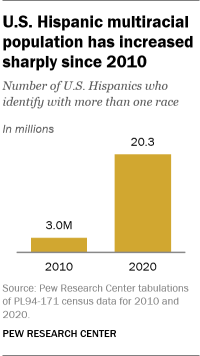
The number of Latinos who say they are multiracial has increased dramatically. More than 20 million Latinos identified with more than one race on the 2020 census, up from just 3 million in 2010. The increase could be due to a number of factors, including changes to the census form that make it easier for people to identify with multiple races and growing racial diversity among Latinos. Growth in multiracial Latinos comes primarily from those who identify as White and “some other race” (i.e., those who write in a response to the race question) – a population that grew from 1.6 million to 17.0 million over the past decade. At the same time, the number of Latinos who identify as White and no other race declined from 26.7 million to 12.6 million.
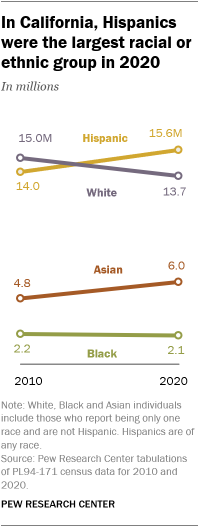
Hispanics have become the largest racial or ethnic group in California. This demographic milestone happened in 2014, and is a first for the state with the nation’s largest Hispanic population. In 2020, there were about 15.6 million Hispanics in California, up from 14.0 million in 2010. The non-Hispanic White population, the next largest group, declined from 15.0 million to 13.7 million during this time, reflecting a broader national trend.
Latinos accounted for 39% of California’s population in 2020, among the highest shares in the country. In the next two largest Latino states by population, Texas (11.4 million) and Florida (5.7 million), Latinos made up 39% and 26% of residents, respectively. New Mexico has 1.0 million Latinos, and they were 48% of the population, the nation’s highest share.
Three states saw their Hispanic populations increase by more than 1 million from 2010 to 2020. Texas (+2.0 million), California (+1.6 million) and Florida (+1.5 million) together accounted for 43% of the nation’s Hispanic population growth over the past decade. New York (+531,000) and New Jersey (+447,000) had the next-biggest increases. All 50 states and the District of Columbia have seen growth in their Hispanic populations since 2010.

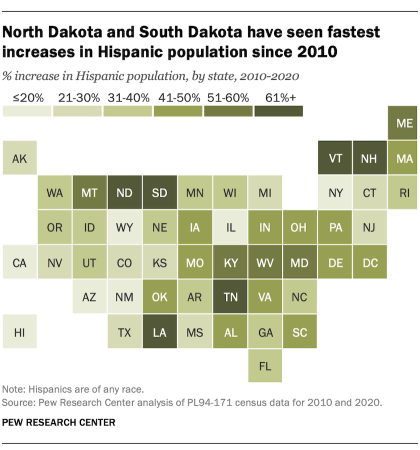
North and South Dakota have seen the fastest growth in their Hispanic populations since 2010. The number of Hispanics in North Dakota more than doubled (+148%) from 2010 to 2020, while in South Dakota it went up 75%. Even with the high growth rates, each of these states now has fewer than 40,000 Hispanics, among the smallest populations in the country. The slowest growth happened in New Mexico (+6%) and California (11%), states with significant Hispanic populations.
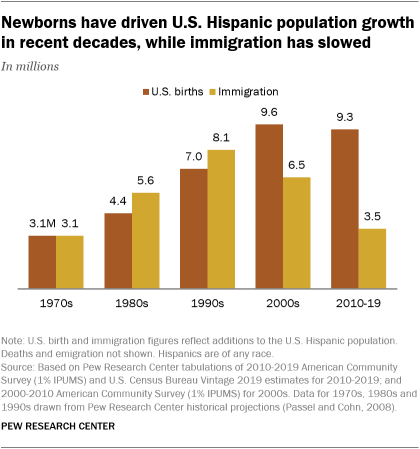
Newborns have driven growth of the U.S. Hispanic population, a trend that accelerated in the 2010s due to a decline in immigration. From 2010 to 2019, 9.3 million Hispanic babies were born in the U.S., similar to the total from the 2000s. By comparison, 3.5 million Hispanic immigrants came to the U.S. from 2010 to 2019, down substantially from the 6.5 million who arrived during the 2000s. This is a reversal of historical trends. In the 1980s and 1990s, immigration drove Hispanic population growth in the U.S. due to more immigrants arriving than babies being born.
The share of Latinos in the U.S. who speak English proficiently is growing. In 2019, 72% of Latinos ages 5 and older spoke English proficiently, up from 59% in 2000. U.S.-born Latinos are driving this growth, as their share on this measure has grown from 81% to 91% during this time. By comparison, 37% of Latino immigrants spoke English proficiently in 2019, a percentage that has increased somewhat since 2000. At the same time, the share of Latinos who speak Spanish at home declined from 2000 to 2019 (78% to 70%). Among the U.S. born, this share has decreased from 66% to 57%. Nearly all Latino immigrants, 94% in 2019, say they speak Spanish at home.
Even though the share of Latinos who speak Spanish at home has declined, the number who do so has grown from 24.6 million in 2000 to 39.1 million in 2019. Meanwhile, 39.8 million Latinos spoke English proficiently in 2019.
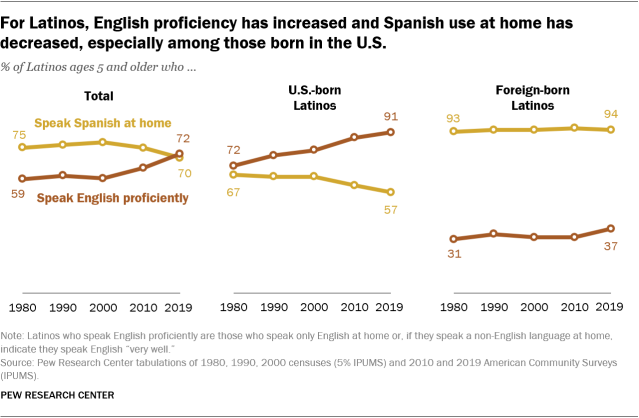
The share of U.S. Hispanics with college experience has increased since 2010.About 42% of U.S. Hispanic adults ages 25 and older had at least some college experience in 2019, up from 36% in 2010. More Hispanic women than Hispanic men have attended college, though the share with some college experience or more increased among both Hispanic women (38% to 45%) and Hispanic men (33% to 39%). Overall, the share of Hispanics with a bachelor’s degree or more education increased during this period, from 13% to 18%.
The number of Latinos enrolled in college also increased from 2010 to 2019, from 2.9 million to 3.6 million. In 2019, women made up a significantly higher share of Latino college students than men, 56% vs. 44%. (A gender gap in college enrollment exists among all racial groups.) Among all U.S. college students, the share of Latinos enrolled in college increased from 14% in 2010 to 19% in 2019.
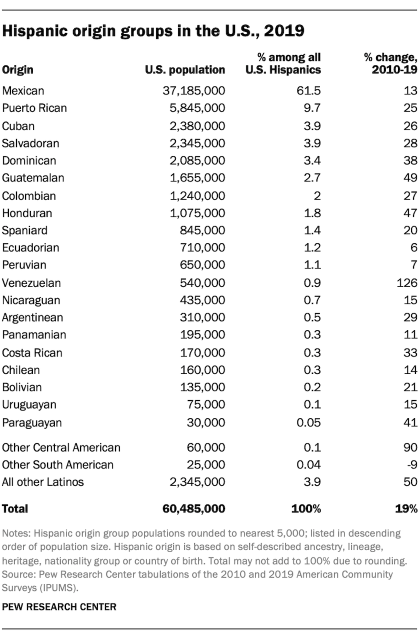
People of Mexican origin accounted for nearly 62% (about 37.2 million) of the nation’s overall Hispanic population as of 2019. Those of Puerto Rican origin are the next largest group, at 5.8 million (another roughly 3.3 million live on the island as of 2020); their numbers have been growing partly due to people leaving Puerto Rico and moving to the 50 states and the District of Columbia. Six other Hispanic origin groups in the U.S. have roughly 1 million or more people each: Cubans, Salvadorans, Dominicans, Guatemalans, Colombians and Hondurans.
The fastest population growth among U.S. Latinos has come among those with origins in Venezuela, Guatemala and Honduras. From 2010 to 2019, the Venezuelan population in the U.S. increased 126% to 540,000, by far the fastest growth rate. Guatemalans saw an increase of 49%, followed by a 47% increase among the Honduran population.
By contrast, the number of people of Mexican origin grew by only 13% from 2010 to 2019, among the lowest growth rates in the top 10 origin groups. At 6%, the Ecuadorian population saw the slowest growth rate among the top origin groups.
Four-in-five Latinos are U.S. citizens. As of 2019, 80% of Latinos living in the country are U.S. citizens, up from 74% in 2010. This includes people born in the U.S. and its territories (including Puerto Rico), people born abroad to American parents and immigrants who have become naturalized citizens. Among the origin groups, virtually all Puerto Ricans are U.S. citizens. Spaniards (93%), Panamanians (88%) and Mexicans (81%) have some of the highest citizenship rates, while Hondurans (51%) and Venezuelans (48%) have the lowest rates.
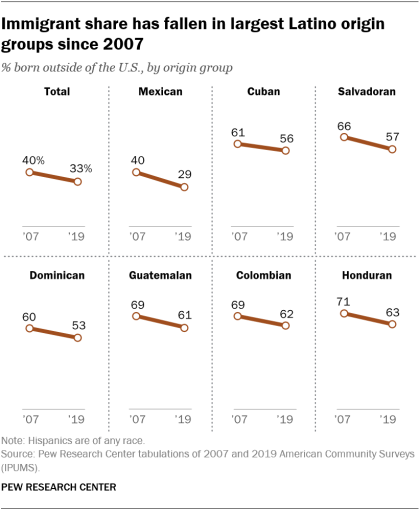
The share of U.S. Latinos who are immigrants is on the decline and varies by origin group. From 2007 to 2019, the number of Latino immigrants increased modestly, from 18.0 million to 19.8 million. But immigrants made up a declining share of the Latino population – decreasing from 40% to 33% during this span as the number of U.S.-born Latinos increased and the arrival of new immigrants slowed.
Fewer than a third of Mexican-origin Latinos (29%) are foreign born. That’s far lower than the shares among the other major groups by population – Hondurans (63%), Colombians (62%), Guatemalans (61%), Salvadorans (57%), Cubans (56%) and Dominicans (53%). Each of these groups saw the immigrant share of their populations decline from 2007 to 2018. By contrast, 77% of Venezuelans are foreign born, the highest of any origin group, and up from 73% in 2007. People born in Puerto Rico are U.S. citizens at birth.



Be the first to comment